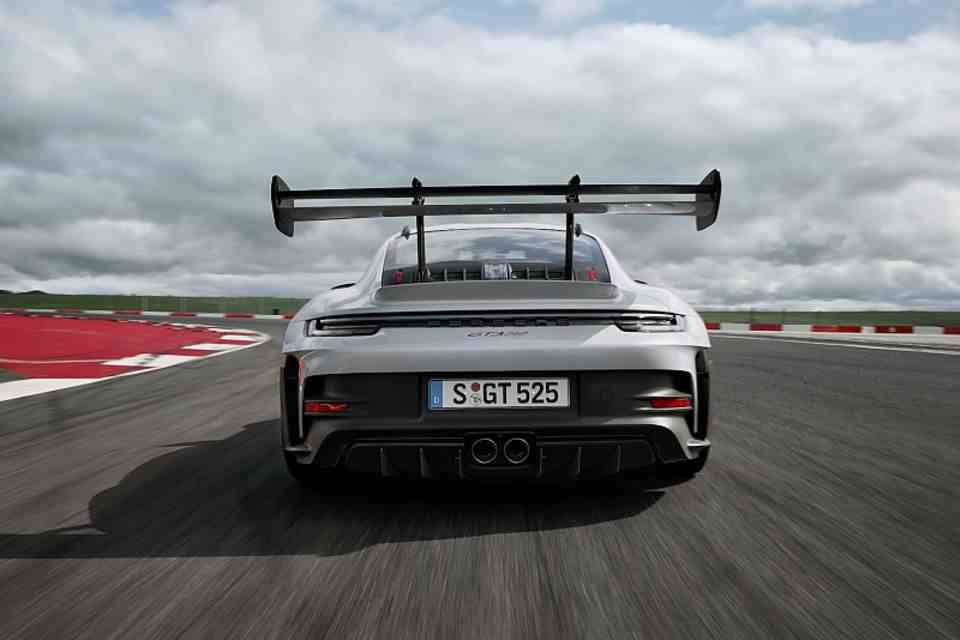New: Porsche 911 GT3 RS
Just stay cool
Porsche 911 GT3 RS series 992
© press-inform – the press office
Porsche is upping the ante with its racing version of the 911 GT3. If you want it a little hotter, you can opt for the 525 hp 911 GT3 RS. You still stay cool – with a new cooling concept in the front end.
When it comes to circuit racing, the Porsche 911 GT3 has been setting standards for years – especially in its current generation of the 992. In order to become even sportier, the cooling and aerodynamic concept of the circuit racer 911 GT3 R was transplanted into the road version of the GT3 RS, which is hardly tamer. Instead of the previous three coolers, the Porsche 911 GT3 RS has, for the first time, a large and sloping center cooler in the front end where the load compartment is usually located. Since the suitcases stay at home and the cooling is now done in the front end, the space that has been freed up on the flanks could be used to integrate active aerodynamic elements. Infinitely adjustable wing elements on the front and on the split rear wing, in combination with other aerodynamic measures, ensure a powerful 409 kilograms of total downforce at a speed of 200 km/h. This means that the new 911 GT3 RS generates twice as much downforce as its predecessor of the 991 type and three times as much as the normal 911 GT3 . At a speed of 285, the downforce increases to 860 kilograms.
For the first time there is a system for variable air resistance adjustment in a production Porsche. With the so-called Drag Reduction System (DRS), the wings can be leveled at the push of a button to ensure low air resistance and higher speed on straight stretches. In the event of emergency braking from high speeds, on the other hand, the air brakes become active by setting the wing elements at the front and rear to the maximum. Spectacular: the rear wing has not only grown again, but for the first time higher than the roof of the 1,450 kilogram Porsche 911 GT3 RS. The changed aerodynamics are even noticeable in the chassis. Since the wheel arch of the new Sport 911 is ventilated, the components of the double wishbone front axle are designed as teardrop profiles, which increases the downforce on the front axle by around 40 kilograms at top speed. The track of the RS is 29 millimeters wider than that of the Porsche 911 GT3. On the front axle, the front ball joint of the lower trailing arm was therefore moved down and the multi-link rear axle was also adjusted with changed spring rates.
Less has happened with the engine, because the four-liter, six-cylinder naturally aspirated engine with 370 kW / 510 hp has had a small increase in output to 386 kW / 525 hp. The individual throttle valve intake system and the rigid valve train are derived from motorsport. The dual-clutch transmission with seven gears has a shorter overall ratio compared to the 911 GT3, which reduces the top speed from 320 to a much slower 296 km/h, which is not particularly important on racetracks. The 911 GT3 RS accelerates from zero to 100 km/h in 3.2 seconds. Its standard consumption: 13.4 liters of Super Plus per 100 kilometers. Aluminum monobloc fixed caliper brakes, each with six pistons, and thicker brake discs with a diameter of 408 millimeters are used on the front axle. The rear axle still has 380 millimeter brake discs and four-piston fixed caliper brakes. Available on request: the ceramic brake. The new Porsche 911 GT3 RS rolls on forged light-alloy wheels with central locking in the format 275/35 R 20 at the front and 335/30 R21 at the rear as standard.
The Porsche 911 GT3 RS, which costs at least 229,517 euros – including a special chronometer – is available with the well-known Clubsport package at no extra charge, which includes, among other things, a roll bar, fire extinguisher and a six-point belt. It gets even sportier with the optional Weissach package, in which, among other things, the front cover, roof, parts of the rear wing and the exterior mirrors are made of carbon. The stabilizers, the rear coupling rods and the thrust area on the rear axle are made of CFRP, while the roll bar, which is also made of CFRP, saves six kilograms in weight. Then the next race can come.


